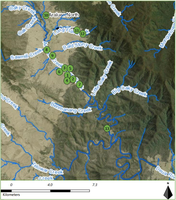Araluen Creek Restoration Project - About the Sites
This project focused on 13 sites along the Araluen Creek and it's tributaries, with each site needing special erosion control measures. From paddock head-cuts, to bank blow-outs, washed out creek crossings and fallen trees - the following provides a summary of each site, as well as some before and after pictures of the earthworks and structures installed.
This is an exert from the Araluen Creek Restoration Project 2021-2023 Report compiled and prepared by Cath Harrison, UDCLG Project Community Liaison Officer. The full report can be found HERE.
Araluen Valley Map: Araluen Creek Restoration Project Site Locations
Key:
- Head-cutting on side creek at dredge hole (L1)
- Bank erosion in main creek at side creek confluence and outside bend (L3)
- Minor erosion to flood-runner sediments (M3)
- Head-cutting in paddock threatening access and creek stability (L2)
- Big tree choke diverting flows into banks and bed (M1)
- Erosion at former sand sausage site (M2)
- Flood diversion leading to severe bank erosion, and other problems (C1)
- Fallen trees and bed erosion (Lease2)
- Severe erosion of outside bend (Lease1)
- Severe bed erosion above main road crossing, Dirty Butter Creek (I1)
- Washed out crossing and bed erosion (H2)
- Washed out crossing and bed erosion (H2)
- Bank erosion and possible flood-runner bed erosion (H&P1)
Site 1: Work ID l1: Headcutting on side creek at dredge hole
- Install rock ramp in upper headcut to control drop and prevent upstream migration.
- Modify drainage in paddock to take water away from lower headcut and discharge safely to main creek.
Site 2. Work ID L3: Bank erosion in main creek at side creek confluence and outside bend
- Install rootballs at confluence point to reduce swirling and erosion.
- Modify shape of inner sandbar on bend to reduce flood pressure on outside of bend.
Site 3. Work ID M3: Minor erosion in floodrunner sediments
- Install rootballs in floodrunner to reduce bed erosion.
Site 4. Work ID: L3: Headcutting in paddock threatening access and creek stability
- Install rock ramp to control water and prevent erosion, and stop upstream migration.
Site 5. Work ID: M1: Big tree choke diverting flows into banks and bed
- Realign fallen trees to prevent floodwater causing erosion to bed and banks, and possible causing creek to permanently realign around choke.
Site 6. Work ID M2: Erosion at former sand sausage site
- Install rootballs at base of erosion to slow floodwater and trap sediment, reducing erosion of the outer bank
- Possible relocation of sediment on inside of bend.
Site 7. Work ID: C1 Flood diversion leading to severe bank erosion, and other problems
- Install rootballs along eroding alignment and open up channel to prevent further erosion.
- Remove large choke in floodrunner.
- Excavate entrance to floodrunner allowing flood capacity.
- Other small-scale bank works by realignment and rootball / fallen tree installation where necessary.
Site 8. Work ID Lease 2: Fallen trees and bed erosion
- Realign fallen trees to prevent bank scour.
- Install log sill below site to prevent bed erosion migrating upstream.
Site 9. Work ID: Lease 1: Severe erosion of outside bed
- Install rootballs in bank toe to prevent erosion.
- Realignment of channel closer to middle of creek.
Site 10. Work ID: I1: Severe bed erosion above main road crossing, Dirty Butter Creek
- Install log weir and rock drop structure to prevent erosion migrating upstream.
Site 11. Work ID: H2 Washed out crossing and bed erosion
- Install log sill below crossing site and reinstate crossing with cobble material.
- Place rootballs on eroding bank above crossing site to prevent outflanking.
Site 12: Work ID H1: Bed erosion downstream of concrete crossing
- Install two log weirs with rock drop protection to prevent bed erosion worsening.
Site 13. Work ID H&P1: Bank erosion and flood runner bed erosion
- Install two layers of root balls to prevent bank erosion and prevent flood runner bed erosion.
This is a Bushfire Community Recovery and Resilience Fund project through the joint Commonwealth/State Disaster Recovery Funding Arrangement




















